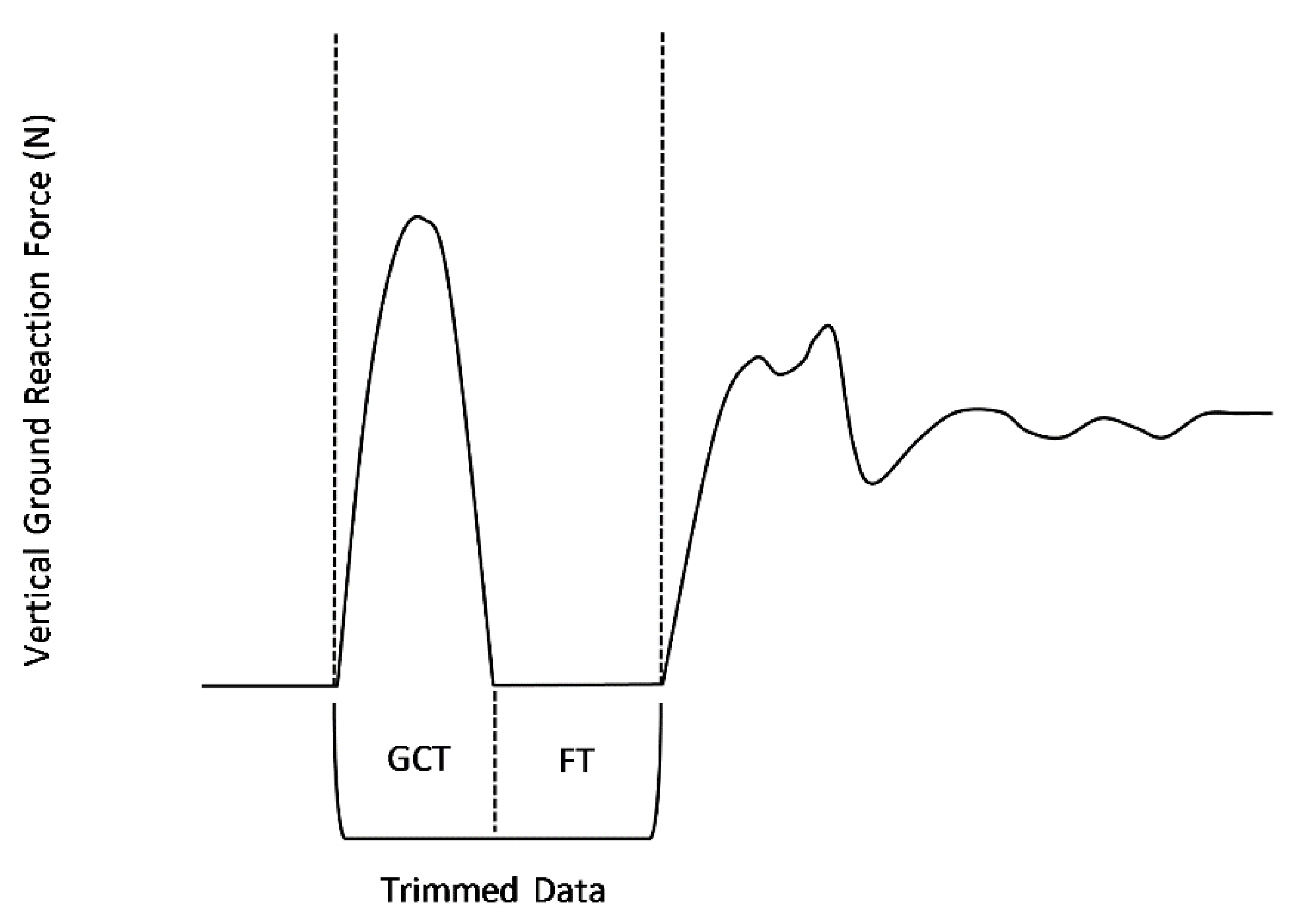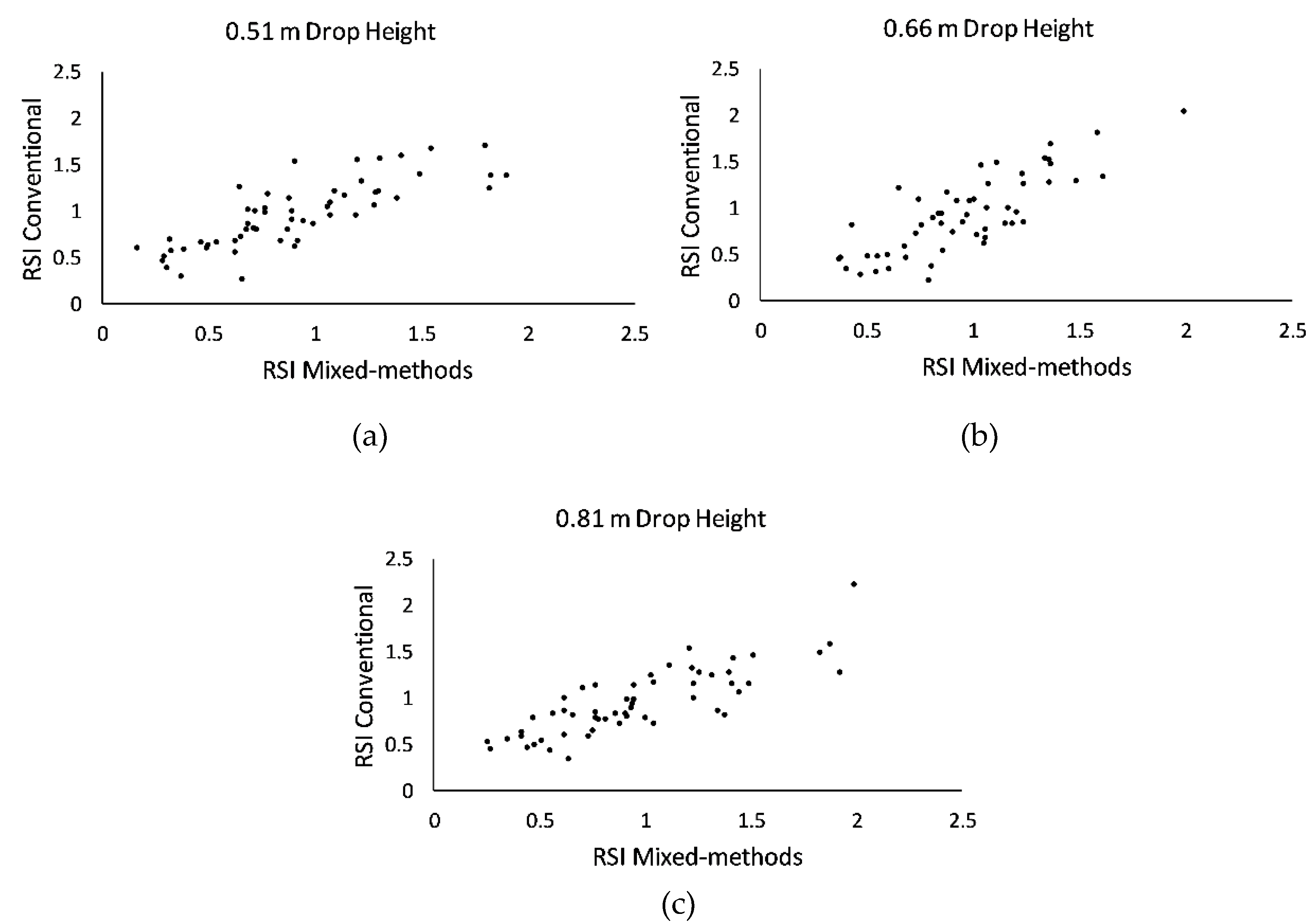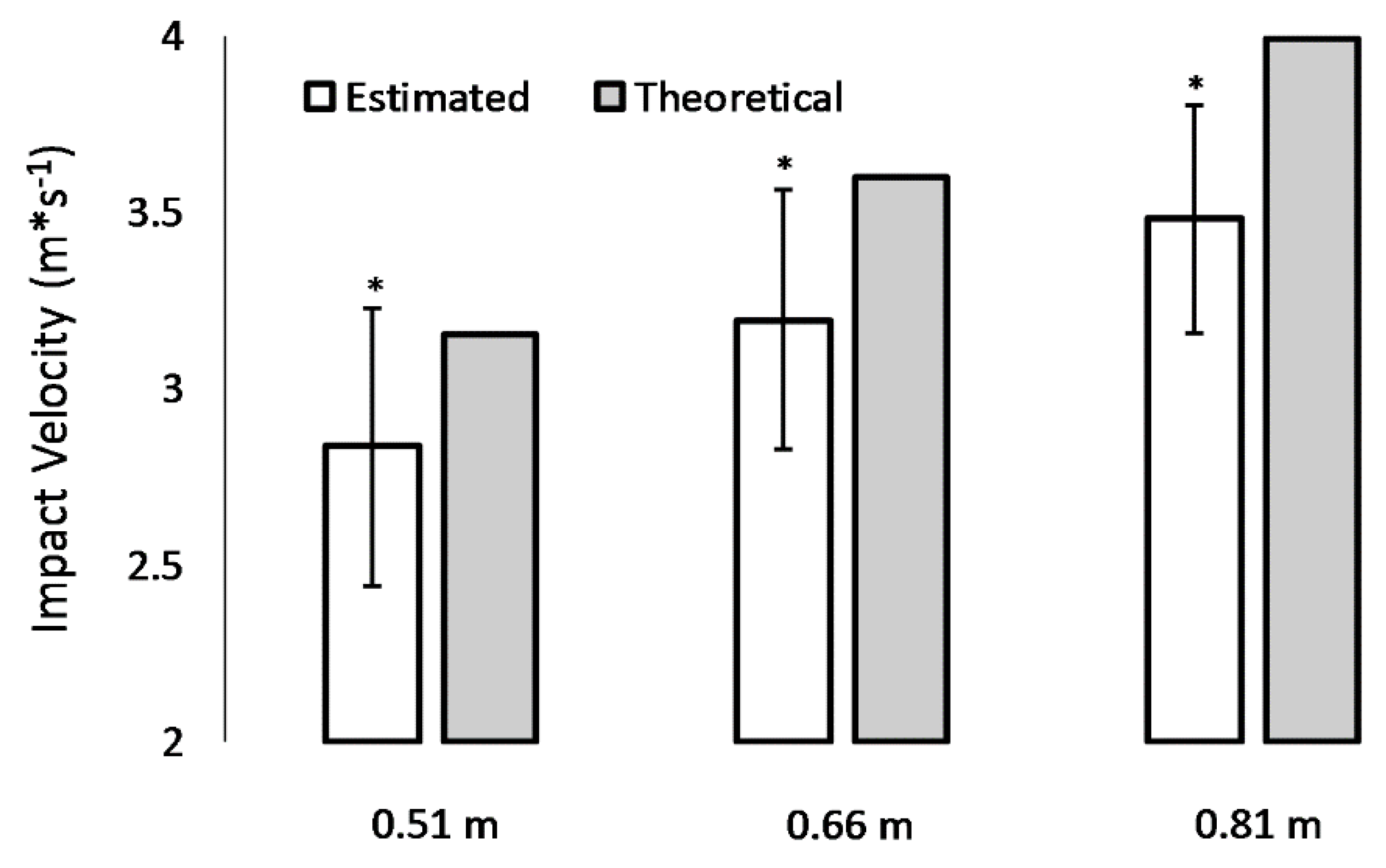A Mixed-Methods Approach to Evaluating the Internal Validity of the Reactive Strength Index
Abstract
:1. Introduction
- Assumption #1: Rebound jump height is often estimated by inputting flight time to an equation of constant acceleration. This approach assumes that the whole-body center of mass is the same distance above the ground at the time instances of rebound jump take-off and rebound jump landing. Specific to the lower extremity, it is typical for the angular positioning of body segments to be more flexed at jump landing versus jump take-off. Therefore, this assumption may threaten the internal validity of conventional RSI computation.
- Assumption #2: The RSI assumes that vertical displacement of the whole-body center of mass during the drop phase of the depth jump is mathematically equivalent to the height of the platform used to perform the drop. This assumption does not introduce threats to internal validity in the conventional computation of the RSI. However, this assumption may introduce threats to internal validity specific to the interpretation of RSI scores. Often, RSI scores are interpreted within the context of drop height. This interpretation assumes that for any two depth jumps, the impact velocity sustained when landing from the drop phase of the depth jump does not vary and can be predicted perfectly using the height of the platform. However, variability in technique when stepping off the platform likely leads to variability in impact velocity that deters from this theoretical assumption.
2. Materials and Methods
2.1. Participants
2.2. Procedures
2.3. Data Analysis
2.3.1. Videography and Body Segment Parameters
2.3.2. Force Platform Dynamometry
2.3.3. RSI Computations
3. Results
3.1. Assumption #1
3.2. Assumption #2
4. Discussion
5. Conclusions
Author Contributions
Funding
Acknowledgments
Conflicts of Interest
References
- Desplenter, T.; Trejos, A. Evaluating muscle activation models for elbow motion estimation. Sensors 2018, 18, 1004. [Google Scholar] [CrossRef] [PubMed]
- Haeufle, D.F.B.; Günther, M.; Bayer, A.; Schmitt, S. Hill-type muscle model with serial damping and eccentric force–velocity relation. J. Biomech. 2014, 47, 1531–1536. [Google Scholar] [CrossRef] [PubMed]
- Millard, M.; Uchida, T.; Seth, A.; Delp, S.L. Flexing computational muscle: Modeling and simulation of musculotendon dynamics. J. Biomech. Eng. 2013, 135, 021005. [Google Scholar] [CrossRef]
- McGuigan, M.R.; Cormack, S.J.; Gill, N.D. Strength and power profiling of athletes: Selecting tests and how to use the information for program design. Strength Cond. J. 2013, 35, 7–14. [Google Scholar] [CrossRef]
- Young, W.B. Laboratory strength assessment of athletes. New Stud. Athlet. 1995, 10, 86–96. [Google Scholar]
- Flanagan, E.P.; Comyns, T.M. The use of contact time and the reactive strength index to optimize fast stretch-shortening cycle training. Strength Cond. J. 2008, 30, 32–38. [Google Scholar] [CrossRef]
- Santello, M. Review of motor control mechanisms underlying impact absorption from falls. Gait. Posture. 2005, 21, 85–94. [Google Scholar] [CrossRef] [PubMed]
- Ball, N.B.; Stock, C.G.; Scurr, J.C. Bilateral contact ground reaction forces and contact times during plyometric drop jumping. J. Strength Cond. Res. 2010, 24, 2762–2769. [Google Scholar] [CrossRef] [PubMed]
- Enoka, R.M. Voluntary Movement. In Neuromechanics of Human Movement, 4th ed.; Human Kinetics: Champaign, IL, USA, 2008. [Google Scholar]
- Baca, A. A comparison of methods for analyzing drop jump performance. Med. Sci. Sports Exerc. 1999, 31, 437–442. [Google Scholar] [CrossRef] [PubMed]
- De Leva, P. Adjustments to Zatsiorsky-Seluyanovs segment inertia parameters. J. Biomech. 1996, 29, 1223–1230. [Google Scholar] [CrossRef]
- Potach, D.H.; Chu, D.A. Program Design and Technique for Plyometric Training. In Essentials of Strength Training and Conditioning, 4th ed.; Haff, G.G., Triplett, N.T., Eds.; Human Kinetics: Champaign, IL, USA, 2015. [Google Scholar]
- Winter, D.A. Signal Processing. In Biomechanics and Motor Control of Human Movement, 4th ed.; John Wiley & Sons: Hoboken, NJ, USA, 2009. [Google Scholar]
- Pavei, G.; Seminati, E.; Cazzola, D.; Minetti, A.E. On the estimation accuracy of the 3D body center of mass trajectory during human locomotion: Inverse vs. forward dynamics. Front. Physiol. 2017, 8, 129. [Google Scholar] [CrossRef] [PubMed]
- Robertson, G.E.; Caldwell, G.E. Planar Kinematics. In Research Methods in Biomechanics, 2nd ed.; Human Kinetics: Champaign, IL, USA, 2018. [Google Scholar]
- Louder, T.J.; Bressel, E.; Nardoni, C.; Dolny, D.G. Biomechanical comparison of loaded countermovement jumps performed on land and in water. J. Strength Cond. Res. 2019, 33, 25–35. [Google Scholar] [CrossRef] [PubMed]



| Drop Height | R2 | F | p-Value | p-Value | Constant | p-Value | |
|---|---|---|---|---|---|---|---|
| 0.51 m | 0.685 | 119.3 | <0.001 | 0.648 | <0.001 | 0.365 | <0.001 |
| 0.66 m | 0.692 | 123.3 | <0.001 | 0.590 | <0.001 | 0.406 | <0.001 |
| 0.81 m | 0.741 | 157.2 | <0.001 | 0.644 | <0.001 | 0.328 | <0.001 |
| Drop Height | RSI Conventional | RSI Mixed-Methods |
|---|---|---|
| 0.51 m | 0.97 ± 0.37 | 0.94 ± 0.48 |
| 0.66 m | 0.99 ± 0.37 | 1.00 ± 0.52 |
| 0.81 m | 0.98 ± 0.38 | 1.00 ± 0.53 |
| Drop Height | RSI Conventional | RSI Mixed-Methods |
|---|---|---|
| 0.51 m | 0.60 | 0.36 |
| 1.00 | 0.98 | |
| 1.40 | 1.60 | |
| 0.66 m | 0.60 | 0.33 |
| 1.00 | 1.01 | |
| 1.40 | 1.68 | |
| 0.81 m | 0.60 | 0.42 |
| 1.00 | 1.04 | |
| 1.40 | 1.66 |
© 2019 by the authors. Licensee MDPI, Basel, Switzerland. This article is an open access article distributed under the terms and conditions of the Creative Commons Attribution (CC BY) license (http://creativecommons.org/licenses/by/4.0/).
Share and Cite
Louder, T.; Thompson, B.J.; Banks, N.; Bressel, E. A Mixed-Methods Approach to Evaluating the Internal Validity of the Reactive Strength Index. Sports 2019, 7, 157. https://doi.org/10.3390/sports7070157
Louder T, Thompson BJ, Banks N, Bressel E. A Mixed-Methods Approach to Evaluating the Internal Validity of the Reactive Strength Index. Sports. 2019; 7(7):157. https://doi.org/10.3390/sports7070157
Chicago/Turabian StyleLouder, Talin, Brennan J. Thompson, Nile Banks, and Eadric Bressel. 2019. "A Mixed-Methods Approach to Evaluating the Internal Validity of the Reactive Strength Index" Sports 7, no. 7: 157. https://doi.org/10.3390/sports7070157
APA StyleLouder, T., Thompson, B. J., Banks, N., & Bressel, E. (2019). A Mixed-Methods Approach to Evaluating the Internal Validity of the Reactive Strength Index. Sports, 7(7), 157. https://doi.org/10.3390/sports7070157





